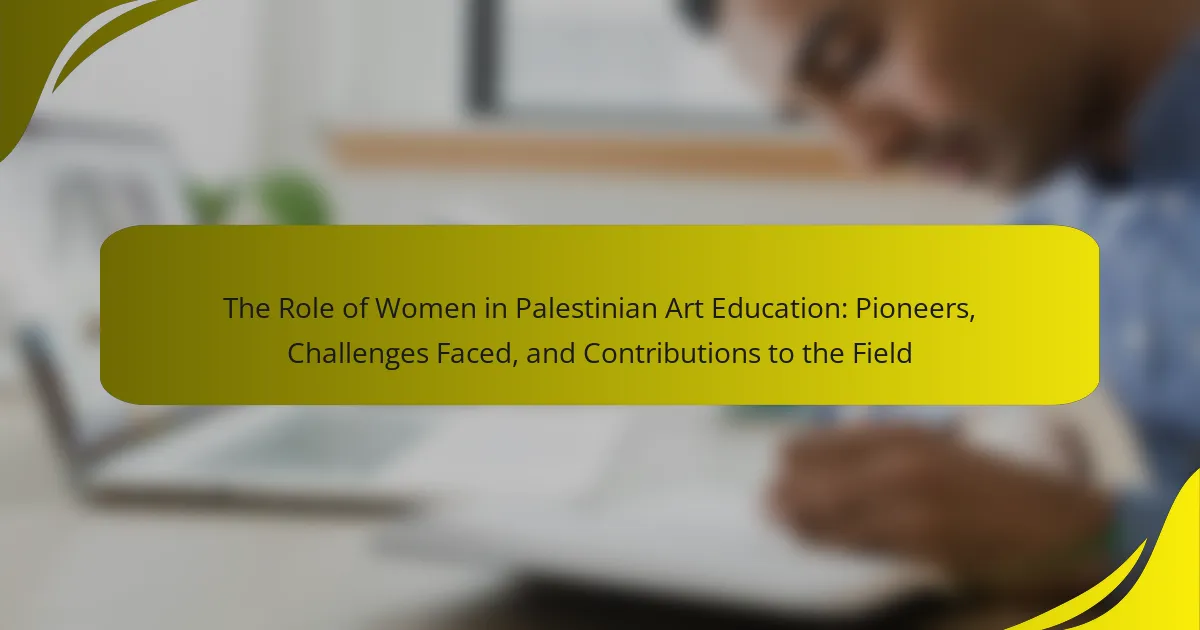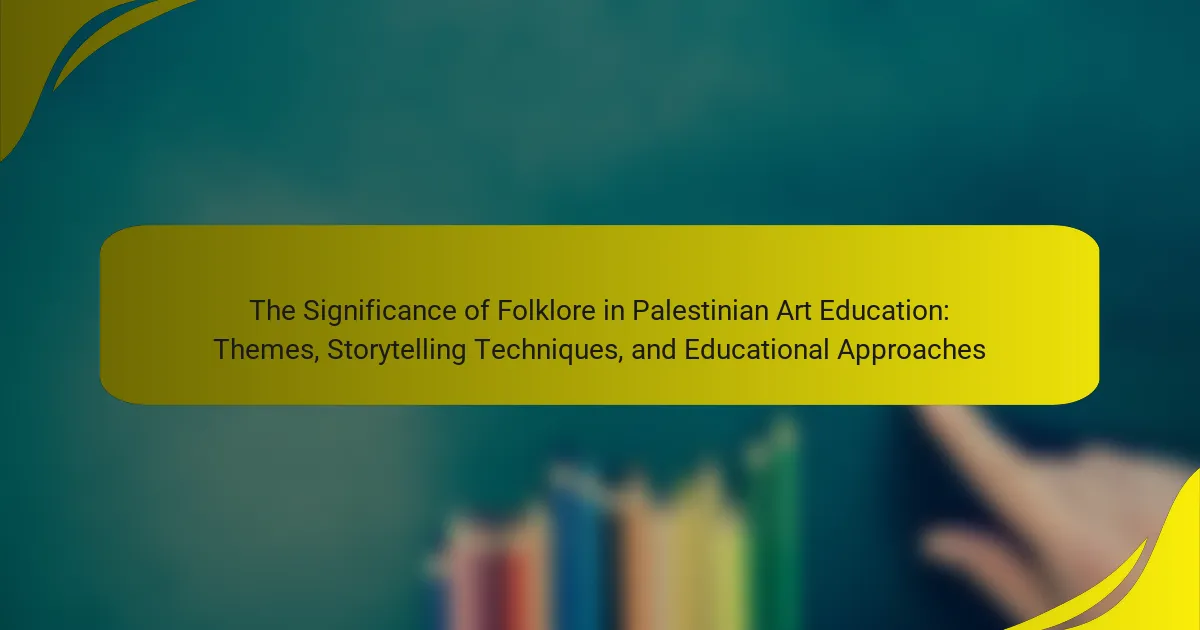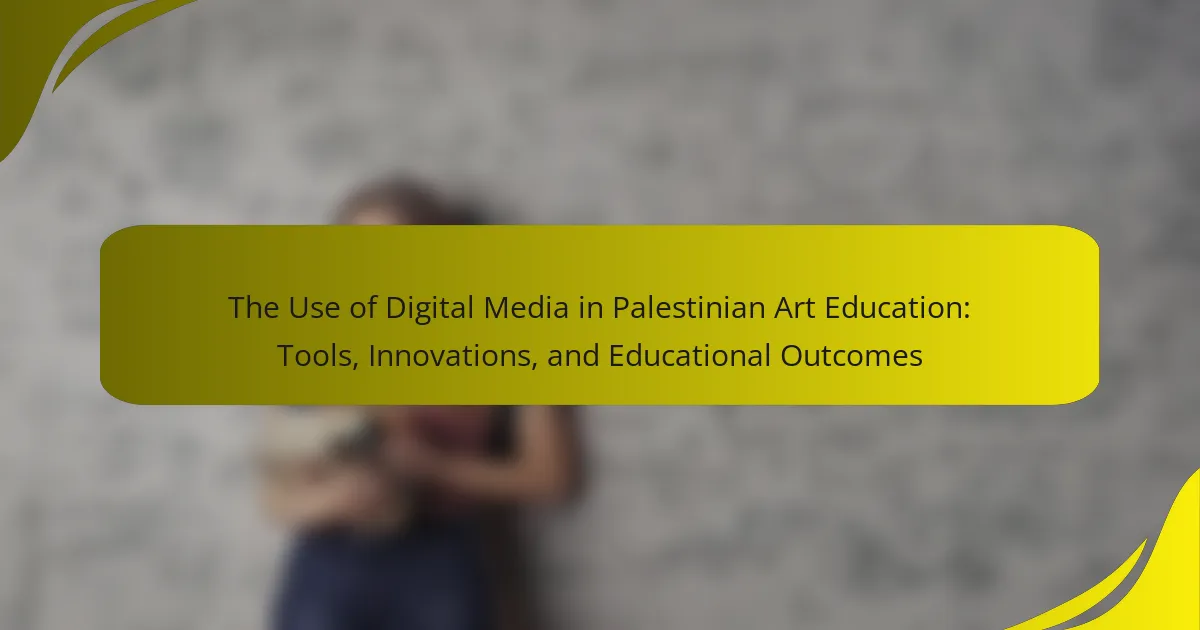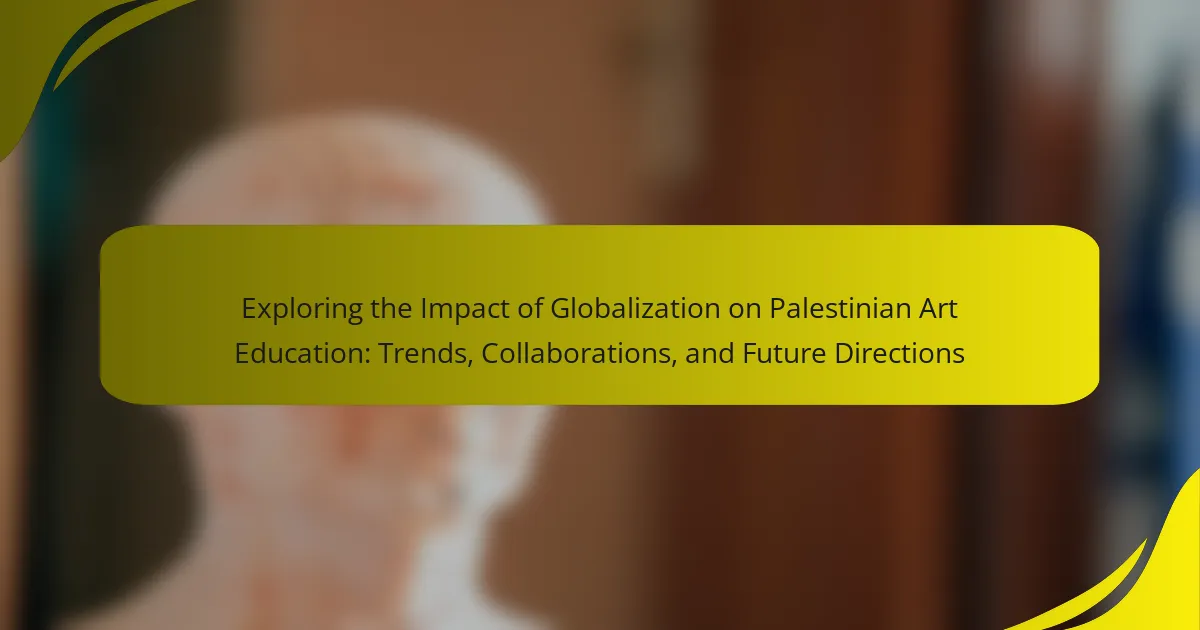Traditional Palestinian crafts, including embroidery, pottery, weaving, and woodwork, play a crucial role in art education by preserving cultural heritage and enhancing students’ creative skills. These crafts are not only significant for their artistic value but also serve as a means of connecting students to their historical identity and fostering critical thinking. The article explores the historical significance of these crafts, the best practices for teaching them in educational settings, and the importance of integrating cultural context into art lessons. It highlights how traditional crafts can enhance cognitive development, promote collaboration, and serve as a form of cultural resistance. Overall, the significance of traditional Palestinian crafts in art education is underscored by their ability to enrich student learning and community connections.
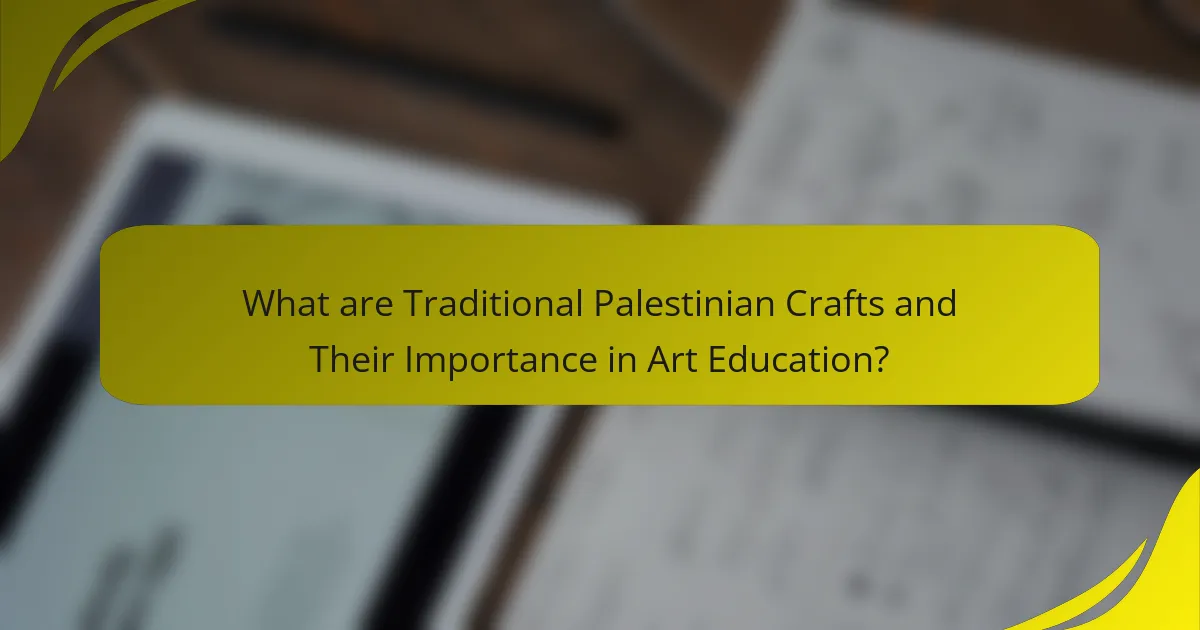
What are Traditional Palestinian Crafts and Their Importance in Art Education?
Traditional Palestinian crafts include embroidery, pottery, weaving, and woodwork. These crafts are vital in art education as they preserve cultural heritage. They connect students to their history and identity. Learning these crafts fosters creativity and fine motor skills. Additionally, traditional crafts promote critical thinking and problem-solving. They encourage collaboration among students through group projects. Studies show that engaging in craft activities enhances cognitive development. Overall, traditional Palestinian crafts play a significant role in enriching art education.
How do Traditional Palestinian Crafts influence the learning process in art education?
Traditional Palestinian crafts significantly influence the learning process in art education by providing cultural context and practical skills. These crafts include embroidery, pottery, and weaving, which are integral to Palestinian heritage. Students learn techniques that have been passed down through generations. This hands-on experience fosters creativity and critical thinking. Additionally, engaging with these crafts promotes an appreciation for cultural identity. Research indicates that students who incorporate traditional crafts into their art education exhibit enhanced motivation and engagement. The historical significance of these crafts enriches the learning experience, linking students to their cultural roots. Overall, traditional Palestinian crafts serve as a vital tool in art education, blending skill development with cultural awareness.
What specific skills do students develop through engaging with these crafts?
Students develop various skills through engaging with traditional Palestinian crafts. These skills include fine motor skills, as the intricate nature of crafts requires precise hand movements. Creativity is enhanced through the process of designing and creating unique pieces. Problem-solving skills are cultivated when students face challenges in their craft projects. Cultural awareness is deepened by learning the historical significance and traditions behind each craft. Collaboration skills improve through group projects and sharing techniques with peers. Attention to detail is sharpened as students focus on the nuances of their work. Finally, perseverance is fostered when students work through the time-consuming processes involved in crafting.
How do these crafts enhance cultural awareness among students?
Traditional Palestinian crafts enhance cultural awareness among students by providing a tangible connection to heritage. Engaging in these crafts allows students to explore historical narratives and cultural significance. For example, weaving and pottery reflect centuries of Palestinian traditions and stories. Students learn about the techniques and materials unique to their culture. This hands-on experience fosters appreciation for craftsmanship and artistic expression. Additionally, crafts often incorporate local symbols and motifs, deepening cultural understanding. Research indicates that art education linked to cultural practices increases empathy and respect for diversity. By participating in these crafts, students develop a broader worldview and a sense of identity.
What techniques are commonly used in Traditional Palestinian Crafts?
Traditional Palestinian crafts utilize various techniques, including embroidery, pottery, weaving, and woodwork. Embroidery techniques often feature intricate patterns and vibrant colors. Pottery techniques include hand-building and glazing, resulting in unique ceramic pieces. Weaving techniques involve using traditional looms to create textiles with cultural significance. Woodwork techniques showcase detailed carvings and craftsmanship in furniture and decorative items. Each technique reflects the rich cultural heritage of Palestine and serves educational purposes in art.
How are these techniques taught in an educational setting?
Traditional Palestinian crafts techniques are taught in educational settings through hands-on workshops and structured curricula. Students engage in practical sessions where they learn specific skills, such as embroidery, pottery, and weaving. These workshops often incorporate historical context to enhance understanding. Educators may use demonstration methods to showcase techniques before students practice them. Collaborative projects encourage peer learning and cultural exchange. Additionally, some programs include visits to local artisans to provide real-world experience. This approach fosters appreciation for cultural heritage and craftsmanship. Research indicates that experiential learning significantly improves skill retention and cultural awareness among students.
What role do traditional techniques play in the preservation of cultural heritage?
Traditional techniques are essential for the preservation of cultural heritage. They serve as a means of transmitting knowledge and skills across generations. These techniques embody the identity and history of a community. For example, traditional Palestinian crafts reflect unique cultural narratives and values. Utilizing local materials, artisans create authentic works that connect past and present. This process fosters a sense of belonging and continuity within communities. Furthermore, traditional techniques often involve specific rituals and practices that enhance cultural significance. By maintaining these methods, communities safeguard their heritage against globalization and cultural homogenization.
What materials are essential for Traditional Palestinian Crafts?
Essential materials for Traditional Palestinian Crafts include olive wood, glass, and textiles. Olive wood is commonly used for carving intricate designs. It is durable and has a rich cultural significance. Glass is often utilized in the form of colorful mosaics and decorative items. This material reflects the region’s historical craftsmanship. Textiles, particularly embroidered fabrics, are essential for creating traditional garments and decorative pieces. They often feature unique patterns that represent local heritage. Other materials include ceramics and metalwork, which are also integral to the craft. Each material contributes to the overall identity and artistry of Palestinian crafts.
How do different materials affect the outcome of the crafts?
Different materials significantly affect the outcome of crafts. Each material brings unique properties that influence texture, durability, and aesthetic appeal. For example, wood offers warmth and a natural finish, while metal provides strength and a modern look. Clay allows for intricate designs due to its malleability. Fabrics can add color and softness, enhancing the overall visual impact.
The choice of material also affects the techniques used in crafting. Traditional Palestinian crafts often utilize locally sourced materials, which can enhance cultural significance. For instance, the use of olive wood in carvings connects artisans to their heritage. Studies show that material selection influences not only the craftsmanship but also the emotional connection to the work.
In summary, the outcome of crafts is profoundly shaped by the materials chosen, impacting both the physical attributes and the cultural narratives embedded in the art.
What are the sourcing and sustainability considerations for these materials?
Sourcing and sustainability considerations for traditional Palestinian craft materials include ethical harvesting and environmental impact. Many materials, such as clay and natural fibers, should be sourced locally to support community economies. Sustainable sourcing minimizes environmental degradation and promotes biodiversity. The use of non-toxic dyes and sustainable practices is essential for preserving the ecosystem. Additionally, traditional methods often rely on renewable resources, ensuring longevity and minimal waste. Studies show that local sourcing can reduce carbon footprints significantly, enhancing overall sustainability. The historical significance of these materials also emphasizes the importance of maintaining cultural heritage while considering modern environmental challenges.
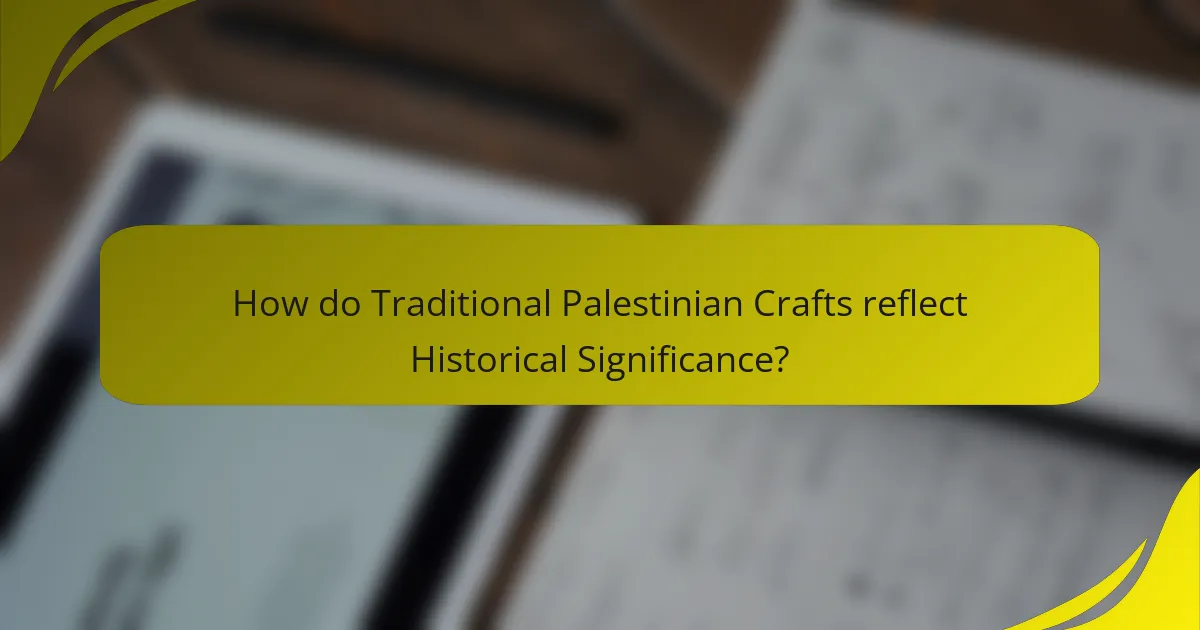
How do Traditional Palestinian Crafts reflect Historical Significance?
Traditional Palestinian crafts reflect historical significance through their representation of cultural identity and heritage. These crafts, such as embroidery, pottery, and weaving, carry narratives of the Palestinian people’s history. Each craft technique has been passed down through generations, preserving traditional methods and stories. The motifs used in these crafts often symbolize historical events and social values. For example, the intricate patterns in Palestinian embroidery represent regional identities and historical experiences. Furthermore, these crafts serve as a form of resistance against cultural erasure. They embody the resilience of Palestinian culture amidst political challenges. The ongoing practice of these crafts maintains a connection to the past, fostering a sense of community and continuity.
What historical events have shaped the development of these crafts?
The development of traditional Palestinian crafts has been shaped by several significant historical events. The Ottoman Empire’s rule from the 16th to the early 20th century introduced various techniques and materials. This period allowed crafts to flourish, with artisans gaining recognition for their work. The British Mandate from 1920 to 1948 further influenced crafts through the introduction of new materials and trade routes.
The 1948 Nakba led to a disruption in traditional crafting practices as many artisans were displaced. This displacement caused a loss of knowledge and skills in some communities. However, the cultural revival in the late 20th century saw a resurgence of interest in traditional crafts. The establishment of organizations aimed at preserving these crafts has helped in their development.
In recent years, the global interest in handmade crafts has provided economic opportunities for artisans. This has allowed traditional Palestinian crafts to gain international recognition and appreciation.
How do these crafts serve as a narrative of Palestinian identity?
Traditional Palestinian crafts serve as a narrative of Palestinian identity by embodying cultural heritage and historical experiences. These crafts include embroidery, pottery, and weaving, which reflect the values, traditions, and struggles of the Palestinian people. Each craft technique carries unique symbolism, often representing local flora, fauna, and historical motifs. For instance, the traditional tatreez embroidery tells stories of family lineage and regional identity through distinct patterns and colors.
Additionally, these crafts have been passed down through generations, preserving collective memory and fostering a sense of community. The act of creating these crafts often involves communal participation, reinforcing social bonds among Palestinians. Furthermore, the resurgence of interest in these crafts in contemporary art reflects a reclaiming of identity amidst displacement and conflict.
This connection to identity is supported by cultural events and workshops that celebrate and teach these crafts, ensuring their survival and relevance. The crafts thus serve not only as artistic expressions but also as vital narratives that encapsulate the resilience and continuity of Palestinian culture.
What symbols and motifs are commonly found in Traditional Palestinian Crafts?
Traditional Palestinian crafts feature symbols and motifs that reflect the region’s heritage and culture. Common symbols include olive trees, representing peace and resilience. Geometric patterns are prevalent, often inspired by Islamic art and architecture. Additionally, motifs of traditional Palestinian dress, such as the embroidered thobe, showcase cultural identity. Birds and floral designs are also frequently depicted, symbolizing freedom and beauty. These motifs are integral to the storytelling aspect of the crafts, conveying historical narratives and personal connections. The use of these symbols is rooted in centuries of tradition, linking contemporary artisans to their ancestors.
Why is it important to integrate Traditional Palestinian Crafts into modern art education?
Integrating Traditional Palestinian Crafts into modern art education is important for cultural preservation. These crafts embody unique historical narratives and artistic techniques. They provide students with a deeper understanding of Palestinian heritage. Incorporating these crafts fosters creativity and innovation in contemporary art practices. Additionally, it encourages respect for diverse artistic traditions. Studies show that experiential learning through crafts enhances student engagement. This integration also promotes social cohesion and cultural dialogue in diverse classrooms. Overall, it enriches the educational experience by connecting students to their cultural roots.
What benefits do students gain from learning about the historical context of these crafts?
Students gain enhanced cultural awareness from learning about the historical context of traditional Palestinian crafts. This awareness fosters appreciation for cultural diversity. Understanding the historical significance deepens students’ connection to their heritage. It also promotes critical thinking by analyzing the socio-economic factors influencing craft development. Additionally, students develop skills in contextual analysis through exploring historical narratives. Engaging with these crafts encourages creativity and innovation in their own work. Historical context provides insight into traditional techniques and materials used, enriching their practical skills. Overall, this knowledge cultivates a sense of identity and belonging among students.
How do these crafts contribute to a broader understanding of global art practices?
Traditional Palestinian crafts enhance the understanding of global art practices by showcasing unique cultural expressions. These crafts exemplify diverse techniques and materials that reflect historical contexts. For example, the intricate patterns in Palestinian embroidery tell stories of identity and heritage. Such crafts offer insights into the socio-political narratives of the region. They also connect local traditions to global artistic movements, illustrating the interplay of cultures. By studying these crafts, art education can incorporate cross-cultural perspectives. This fosters appreciation for the richness of global art practices. Ultimately, these crafts serve as a bridge between local and international artistic dialogues.
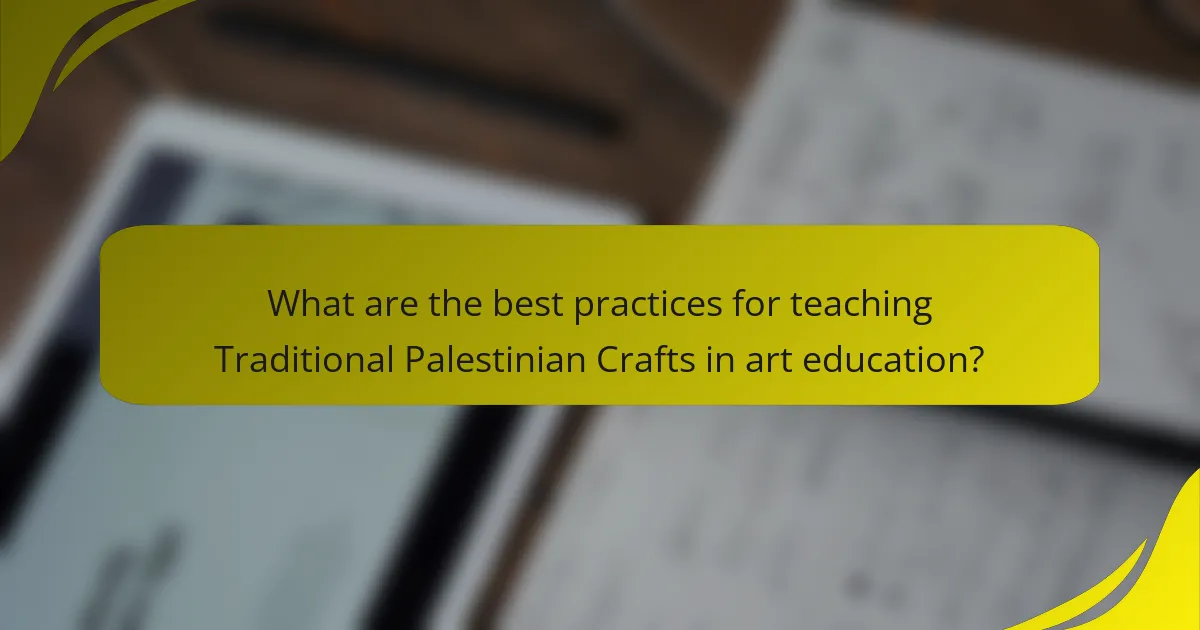
What are the best practices for teaching Traditional Palestinian Crafts in art education?
Best practices for teaching Traditional Palestinian Crafts in art education include integrating cultural context into lessons. This ensures students understand the significance of the crafts. Hands-on workshops allow students to engage directly with materials and techniques. Utilizing local artisans as guest instructors enhances authenticity in the learning experience.
Encouraging creativity while respecting traditional methods fosters individual expression. Providing resources that showcase the history and evolution of these crafts enriches students’ knowledge. Assessing student work through both skill and cultural understanding promotes a comprehensive evaluation. Collaborating with community organizations can help preserve and promote these crafts outside the classroom.
How can educators effectively incorporate these crafts into their curriculum?
Educators can effectively incorporate traditional Palestinian crafts into their curriculum by integrating hands-on projects that reflect cultural significance. This approach allows students to engage with history and art simultaneously. For instance, lessons can include weaving, pottery, or embroidery techniques. Each craft can be tied to specific historical contexts or cultural stories. Educators should provide students with materials that are authentic to these crafts. This enhances the learning experience and fosters respect for cultural heritage. Additionally, incorporating community experts or artisans can enrich the curriculum. Their firsthand knowledge can provide deeper insights into the techniques and significance of the crafts. By aligning these activities with educational standards, educators can ensure they meet learning objectives while celebrating cultural diversity.
What resources are available for teachers to learn about Traditional Palestinian Crafts?
Teachers can access various resources to learn about Traditional Palestinian Crafts. Educational websites offer lesson plans and background information. Books focusing on Palestinian culture and crafts provide in-depth insights. Online workshops and webinars often feature experts in traditional crafts. Museums and cultural centers frequently host exhibitions and workshops. Documentaries and videos showcase craft techniques and their significance. Academic journals publish research on the historical context of these crafts. Collaborations with local artisans can enhance practical learning experiences. These resources collectively support teachers in integrating traditional crafts into art education.
What challenges might educators face when teaching Traditional Palestinian Crafts?
Educators face several challenges when teaching Traditional Palestinian Crafts. Limited access to authentic materials can hinder the learning experience. Cultural sensitivity is crucial, as these crafts are tied to identity and heritage. Additionally, educators may encounter a lack of resources for comprehensive lesson plans. Students’ varying levels of interest and background knowledge can also pose difficulties. Furthermore, the political context may affect the availability of workshops or artisans to collaborate with. Lastly, there might be challenges in integrating these crafts into broader art education curricula.
How can educators overcome these challenges to enhance learning experiences?
Educators can overcome challenges by integrating traditional Palestinian crafts into their curriculum. This approach fosters cultural appreciation and enhances creativity. Utilizing local materials makes lessons more accessible and relatable. Hands-on activities engage students and promote active learning. Collaborating with local artisans enriches the educational experience. Research shows that experiential learning improves retention and understanding. Studies indicate that students exposed to cultural crafts demonstrate higher motivation. By addressing these elements, educators can significantly enhance learning experiences.
The main entity of the article is Traditional Palestinian Crafts, which encompass techniques such as embroidery, pottery, weaving, and woodwork. These crafts are crucial in art education as they preserve cultural heritage, enhance creativity, and develop fine motor skills among students. The article explores the historical significance of these crafts, their role in fostering cultural awareness, and the specific skills students gain through engagement. Additionally, it discusses the materials used in these crafts, sourcing and sustainability considerations, and best practices for integrating them into modern art education. Overall, it highlights how traditional Palestinian crafts serve as a vital tool for cultural preservation and educational enrichment.
